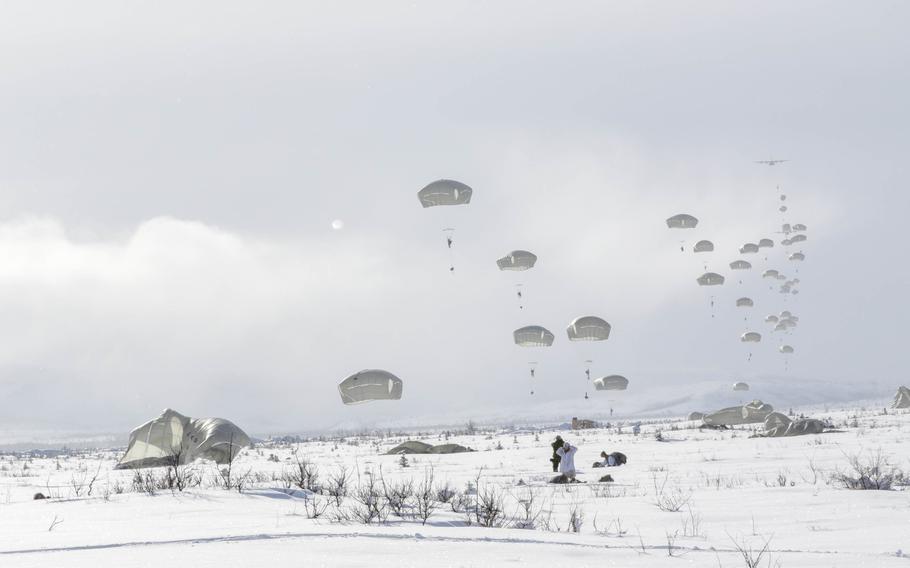
Paratroopers from the 1st Battalion, 501st Parachute Infantry Regiment, part of 4th Brigade, 25th Infantry Division assigned to U.S. Army Alaska, parachute onto Donnelly Drop Zone near Fort Greely, Alaska, March 11, 2022. (Christopher Dennis/U.S. Army)
U.S. Army Alaska will be redesignated the 11th Airborne Division with the aim of instilling a better defined “sense of identity” for soldiers as the service grapples with troop suicides in the state, the secretary of the Army told lawmakers Thursday.
U.S. Army Alaska has already instituted multiple initiatives aimed at lowering the risks of suicide or detecting those most vulnerable, even as soldiers there have been tasked with implementing the service’s ambitious Arctic strategy.
“One of the things we’ve found that we think is contributing to what we’ve found in Alaska is that some soldiers there don’t feel like they have a sense of identity or purpose around why they’re stationed there,” Army Secretary Christine Wormuth said during a hearing of the Senate Armed Services Committee.
Soldiers under U.S. Army Alaska wear the “Tropic Lightning” patch of the Hawaii-based 25th Infantry Division, but the mission sets for soldiers in each location are quite distinct. Hawaii soldiers train for fighting in humid, jungle terrain, while Alaska’s soldiers are now being organized, equipped and trained as a cold-weather fighting force that can carry out the “Regaining Arctic Dominance” strategy issued by the Army in March 2021.
“We’re not adding or subtracting force structure,” Wormuth said. “It’s really sort of more of a new sense of common identity for the soldiers up there.”
Reflagging to the 11th Airborne Division taps into a “great history and heritage, and that means a lot to soldiers,” Gen. James McConville, chief of staff of the Army, told the committee.
“You build a cohesive team around a mission, and you give them focus,” he said. “You give them identity. That’s what brings them together, and that’s what we’re going to try to do.”
The division traces its lineage to World War II, where its soldiers first saw combat in the Philippines. It has been inactivated since 1965.
The Army maintains two other airborne divisions, the 82nd at Fort Bragg, N.C., and the 101st at Fort Campbell, Ky., although the latter is a light infantry division specializing in air assault operations.
The new 11th Airborne Division would become the Army's second paratrooper division, according to a news release Thursday from Sen. Dan Sullivan, R-Alaska, who sits on the Armed Services Committee.
The current 1st Brigade Combat Team, based at Ft. Wainwright, and 4th Brigade Combat Team, at Elmendorf-Richardson, will be redesignated as the 1st and 2nd Brigade Combat Teams under the new division, according to the release.
Suicide among Alaska-based soldiers has been on the rise since 2019, with a dramatic leap in the number last year.
Seven soldiers died by suicide in the state in 2020, and that number jumped to 11 in 2021, a figure that excludes six soldier deaths still under investigation.
Soldiers in the state are primarily stationed at Fort Wainwright in Fairbanks or Joint Base Elmendorf-Richardson in Anchorage, where U.S. Army Alaska is headquartered.
Wormuth told the committee that the Army is “trying to surge a significant quantity of behavioral health providers” to Alaskan bases in response to suicides. That includes sending chaplains and personnel from the Military and Family Life Counseling Program, she said.
“That will be a six-month surge, and we will be doing a 100% mental health checks of every U.S. Army Alaska soldier,” she said.
A report released last month by the Government Accountability Office concluded that service members stationed in Alaska, Hawaii and other overseas installations defined as “remote” appeared to be more at risk of attempting suicide than their counterparts in the U.S. mainland.